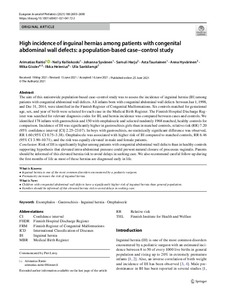High incidence of inguinal hernias among patients with congenital abdominal wall defects: a population-based case-control study
Raitio Arimatias; Kalliokoski Nelly; Syvänen Johanna; Harju Samuli; Tauriainen Asta; Hyvärinen Anna; Gissler Mika; Helenius Ilkka; Sankilampi Ulla
https://urn.fi/URN:NBN:fi-fe2022081153711
Tiivistelmä
The aim of this nationwide population-based case-control study was to assess the incidence of inguinal hernia (IH) among patients with congenital abdominal wall defects. All infants born with congenital abdominal wall defects between Jan 1, 1998, and Dec 31, 2014, were identified in the Finnish Register of Congenital Malformations. Six controls matched for gestational age, sex, and year of birth were selected for each case in the Medical Birth Register. The Finnish Hospital Discharge Register was searched for relevant diagnosis codes for IH, and hernia incidence was compared between cases and controls. We identified 178 infants with gastroschisis and 150 with omphalocele and selected randomly 1968 matched, healthy controls for comparison. Incidence of IH was significantly higher in gastroschisis girls than in matched controls, relative risk (RR) 7.20 (95% confidence interval [CI] 2.25-23.07). In boys with gastroschisis, no statistically significant difference was observed, RR 1.60 (95% CI 0.75-3.38). Omphalocele was associated with higher risk of IH compared to matched controls, RR 6.46 (95% CI 3.90-10.71), and the risk was equally elevated in male and female patients.Conclusion: Risk of IH is significantly higher among patients with congenital abdominal wall defects than in healthy controls supporting hypothesis that elevated intra-abdominal pressure could prevent natural closure of processus vaginalis. Parents should be informed of this elevated hernia risk to avoid delays in seeking care. We also recommend careful follow-up during the first months of life as most of these hernias are diagnosed early in life.
Kokoelmat
- Rinnakkaistallenteet [27094]
